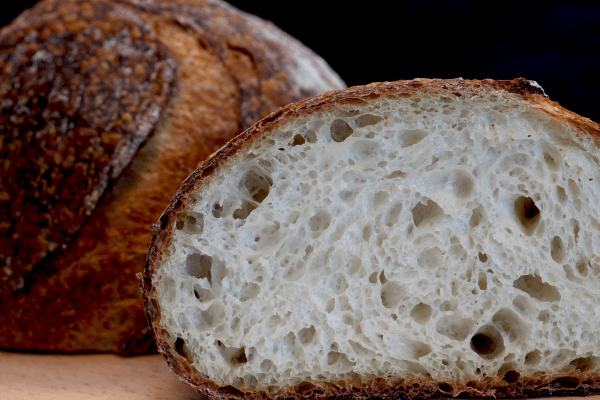Do you fancy a slice of sourdough toast to go with your eggs? Though some individuals savour the unique taste and texture of sourdough bread, it can be an acquired taste for others.
What is sourdough?
Sourdough is one of the oldest forms of leavened bread which was an accidental discovery in early 2000 BC in Egypt. It was discovered as a result of wild yeast drifting into old dough leading to the fermentation of good bacteria and the tasty sourdough bread.
The sourdough is made by grinding and consequent fermentation of cereals or pseudo cereals or legumes. Based on the method of fermentation, sourdough bread can be classified as:
Type 1 sourdough – Traditional method of making sourdough by backslopping. This is further classified as:
Type 1a – Uses pure sourdough culture starter
- Type 1a – Uses pure sourdough culture starter.
- Type 1b – Dough is refreshed daily followed by fermentation.
- Type 1c – The origin of the sourdough is tropical countries with higher temperatures.
Type 2 sourdough – Sourdough is inoculated with acidifiers
Type 3 sourdough – This is the dried form of sourdough which is easy to store and use.
Type 0 sourdough – This form contains baker’s yeast.
Type 2 and type 3 are commonly used by commercial sourdough bread manufacturers.
In the past few years there has been increasing attention to the health benefits of sourdough bread, but is this ancient bread really that healthy?
Sourdough bread vs modern bread
| Sourdough bread | Modern bread | |
| Method of fermentation | It uses a natural fermentation process | It uses baker’s yeast for fermentation |
| Duration of fermentation | Takes a few weeks/months or years to ferment | Takes a few hours to ferment |
| Additives and preservatives | Due to the natural fermentation, there is no need to add artificial preservatives and additives | It has a shorter shelf life. Chemical preservatives and additives are commonly added to extend shelf life. |
| Cost | It is expensive | It is cheaper and more affordable |
| Palatability | It is chewy and has a sour taste | It is sweet and soft |
Nutritional value of sourdough bread varieties vs modern bread varieties
| Nutrient value/100g | White sourdough loaf | Whole grain sourdough loaf | Regular white loaf | Regular whole grain loaf |
| Energy (Kcal) | ~243 | ~243 | ~250 | ~237 |
| Protein (g) | 8.5 | 10 | 8.5 | 10.6 |
| Carbohydrates (g) | 45 | 40.8 | 46.3 | 37.9 |
| Dietary fibre (g) | 3.2 | 6.0 | 3.1 | 7.0 |
*An approximate of nutrient values of different varieties as cited in a study
Nutritional benefits of sourdough bread
A study revealed the following nutritional benefits of sourdough bread:
- Better nutrient availability – Sourdough fermentation increases the bioavailability of minerals such as iron, zinc etc. by 10-25%. The fermentable sugars such as polyols and mannitols increase which acts as food for the gut microbiota. Sourdough also contains a higher vitamin B12, folate and riboflavin.
- Lower phytic acid content – Phytic acid is a natural constituent of grains which has the capacity to bind to nutrients (ex. Calcium, magnesium, zinc, salt, iron etc.) and prevent their absorption. Sourdough bread fermentation can break down the phytic acid content by 96.6%, especially in type 2 sourdough fermentation.
- Degrades anti-nutritional factors (ANF) – ANF can cause severe illnesses. Raffinose, tannins, vicine, convicine, saponins etc. are found in wheat. They can also cause gut issues. Bacteria which help in sourdough bread fermentation produce enzymes such as galactosidase, glucosidase, and tannases which can neutralise ANF.
- Has prebiotics and post-biotics – Though most probiotics present in the dough die during baking, their health benefits remain not by the bacteria in itself but by the metabolites produced during fermentation. Microbial metabolites and cellular structure during the fermentation are the source of postbiotic-like components. Ex. of postbiotics – Short-chain fatty acids (SCFA), proteins, peptides, bacteriocins etc. SCFA helps in reducing inflammation and also prevention of cancer cells.
- It has dietary fibre – Sourdough fermentation increases the availability of dietary fibre present in the bread. This is because the fermentation activates enzymes cellulases and hemicellulases which break down the cell wall and increase the accessibility of dietary fibre.
- Rich in resistant starch – Sourdough fermentation can increase the resistant starch in bread by 89-120%. Resistant starch does not get digested in the small intestine and this inturn enables the bacteria in the large intestine to ferment it instead. Thus improving digestive health and gut microflora, lowering postprandial insulin and glucose levels etc.
- Lower in glycaemic index – The digestibility of sourdough bread is higher than modern bread. Sourdough fermentation can reduce the Rapidly digestible starch (RDS) by 50%. RDS is usually responsible for triggering a high glycaemic response. In addition, the higher dietary fibre, slow gastric emptying, activation of satiety hormones, resistant starch etc. contribute to a lower glycaemic index.
| Starch and cereal products | Glycaemic index (GI) |
| Glucose | 100 |
| Wheat French baguette | 95 |
| Whole grain rye sourdough bread | 53 |
| White wheat flour bread | 75 |
| Whole grain rye bread | 58 |
| Whole grain wheat bread | 74 |
| White macaroni pasta (boiled) | 50 |
| White spaghetti pasta (boiled) | 41 |
| Potato (boiled) | 53 |
| White rice | 53 |
| Sweet potato | 61 |
*Glycaemic index table as cited in a study
- Lower in FODMAP – FODMAP is a group of short-chain carbohydrates which contains – Fermentable oligosaccharides, disaccharides, monosaccharides and polyols. These usually cause digestive discomfort in individuals with irritable bowel syndrome (IBS) and other gut issues. Sourdough fermentation can reduce all FODMAP content except polyols in wheat bread. However, the major fermentation and breakdown of fructans in wheat results in a lower FODMAP sourdough. The strain of bacteria used for fermentation will determine the level of FODMAP breakdown. Type 1 sourdough is the best method of fermentation to reduce FODMAP in sourdough.
- Lower in acrylamide – Certain strains of lactic acid bacteria (LAB) can reduce the carcinogenic compound – Acrylamide. This is formed by the Maillard reaction of starches.
Health claims of sourdough bread
Though there have been several studies on the various health benefits of sourdough bread such as – Glycaemic response, gastrointestinal distress, cardiovascular health, appetite, satiety metabolic diseases etc. there is insufficient evidence to prove the same due to contradicting results. However, sourdough bread does have an upper hand in terms of nutritional properties over modern bread.
Negative aspects of sourdough bread
- Sourdough bread making is a labour-intensive process which makes it expensive and not affordable to all.
- The taste and flavour of the bread is not appealing or preferred by all.
- Sourdough bread does contain gluten.
- Sourdough bread still contributes to the high starch content of the daily diet.
- It is not easily available.
- Packaging labels can be misleading as the exact type of sourdough bread is not mentioned and neither is the strain of bacteria.
Who should not consume sourdough bread?
No, sourdough is not safe for all individuals to consume.
- If you have an allergy to wheat or coeliac disease please refrain from consuming sourdough bread as it still does contain gluten.
- If you take MAOI (monoamine oxidase inhibitors) for depression please restrict the consumption of sourdough as it may contain the amino acid tyramine which can increase blood pressure.
Mayuri,
Dietetic Researcher, Simplyweight





